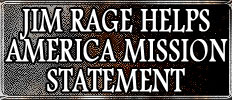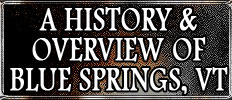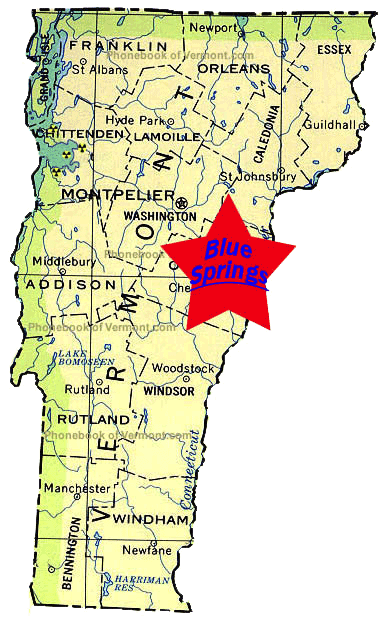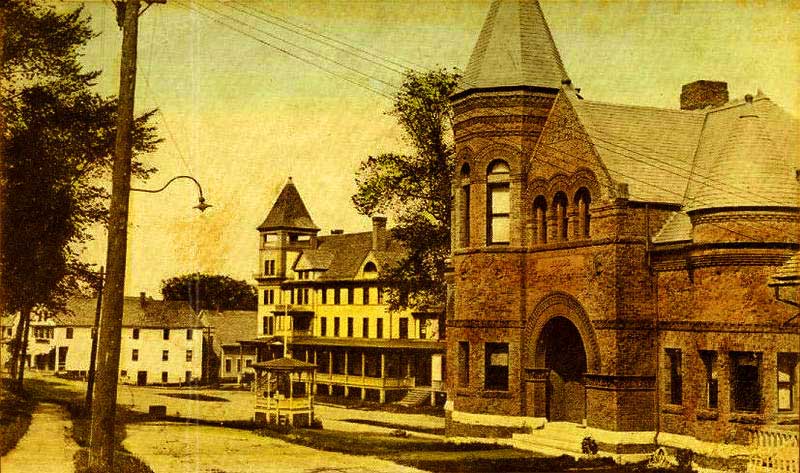    |
|---|
Selected excerpts from “Blue Springs: Our Heritage” by Ursula Stuart

![]() History:
History:
Blue Springs was first settled by German immigrant Johann Zeigler and his family in 1810. Built almost entirely upon an Indian burial ground, Blue Springs was originally referred to as “Blau Federung” but the less-German name of Blue Springs was adopted by the Vermont General Assembly in 1835. The primary industry of Blue Springs was mushrooming, until the railroad came through in 1864 and the town shifted towards the timber trade and grist mills. But, once the grist-bubble finally burst in 1915, the market collapsed and many of these companies dissolved. The original Ulbrecht and Sons Mill building still stands in the town center today, now serving as a shopping plaza that houses a Super-Cuts hair salon and a Subway Sandwich Shop.
![]() The first known zombie incident of Blue Springs occurred in 1868. As recorded in The History of Blue Springs 1860-1964 by Irene Grady, a townswoman was distraught over the death of her son in the Civil War and took to occult methods to return him to life. According to legend, she conducted an arcane ceremony while wearing the ribcage of a feral dog like a hat. As is typical in this sort of thing, her son was brought back as a mindless creature of violence. Eventually the townsfolk succeeded in trapping the undead thing inside a barrel, which they weighted down and sunk in nearby Azure Lake. The mother was hanged for witchcraft and disturbing the peace.
The first known zombie incident of Blue Springs occurred in 1868. As recorded in The History of Blue Springs 1860-1964 by Irene Grady, a townswoman was distraught over the death of her son in the Civil War and took to occult methods to return him to life. According to legend, she conducted an arcane ceremony while wearing the ribcage of a feral dog like a hat. As is typical in this sort of thing, her son was brought back as a mindless creature of violence. Eventually the townsfolk succeeded in trapping the undead thing inside a barrel, which they weighted down and sunk in nearby Azure Lake. The mother was hanged for witchcraft and disturbing the peace.
![]() Since that time, Blue Springs has been generally considered to be the center of undead activity in Vermont, if not New England. The town has been repeatedly troubled by radioactive contamination, Satan worship, meteorite impacts, and milfoil. Many have linked this to the town’s persistent economic woes. Most recently, in 2006, 216 people were killed in a massive explosion, along with all of the original members of the hard-rock band Kiss. This severely hurt local business, although the Kiss franchise endures through the use of professional impersonators and archived footage.
Since that time, Blue Springs has been generally considered to be the center of undead activity in Vermont, if not New England. The town has been repeatedly troubled by radioactive contamination, Satan worship, meteorite impacts, and milfoil. Many have linked this to the town’s persistent economic woes. Most recently, in 2006, 216 people were killed in a massive explosion, along with all of the original members of the hard-rock band Kiss. This severely hurt local business, although the Kiss franchise endures through the use of professional impersonators and archived footage.
![]() Currently, Blue Springs has managed to regain something approaching stability thanks to the successful zombie awareness campaign that popularized the F.A.S.T system of identifying the undead, along with “Run Away” seminars held at the Blue Springs Elementary School. The zombie problem has also been regularly managed by Jim Rage’s Elite Zombie Hunting Squadron, which has operated out of the town since 1986. It’s not the business Blue Springs deserves, but the one it needs. JREZHS is Blue Springs’ silent guardian; a watchful protector. In short: a consistent source of much-needed tax revenue.
Currently, Blue Springs has managed to regain something approaching stability thanks to the successful zombie awareness campaign that popularized the F.A.S.T system of identifying the undead, along with “Run Away” seminars held at the Blue Springs Elementary School. The zombie problem has also been regularly managed by Jim Rage’s Elite Zombie Hunting Squadron, which has operated out of the town since 1986. It’s not the business Blue Springs deserves, but the one it needs. JREZHS is Blue Springs’ silent guardian; a watchful protector. In short: a consistent source of much-needed tax revenue.
Geography and Demographics:
![]()
Located in Orange County, Blue Springs is thought to be around 35 square miles, but no precise measurements have ever been made due to survey teams being eaten. The town center and village green are located next to the eponymous Blue Springs, which serves as the town’s primary source of water. There are currently 2567 residents in Blue Springs, and all of them are fine, upstanding people.
Places to visit in Blue Springs include:
-Mr. Hooper’s General Store and Feed Supply, where you can purchase tiny bottles of maple syrup for $19.95.
-Historic Stuart Street, which appears in a deleted scene from Robert Zemeckis’ What Lies Beneath.
-Upper Valley Lanes, Games, Guns, and Peace: New England’s only combination yoga studio/ shooting range/ bowling alley.
-Azure Lake: no fishing, swimming, or boating.
-The Zentner House, built in 1825. Blue Springs oldest structure and home to the Grist Museum.
-The Pit: a large unfinished mine-shaft and an ideal location for garbage disposal
-Beryl Hill Cemetery: the most heavily fortified graveyard in the world and a “miracle of design” as described by Jim Rage.
-The Colonel Russell Murphy Memorial Statue (“Get your picture taken with the tall man of metal!”)
-The Forbidden Zone, which will be radioactive until 2099 thanks to an infamous zombie episode.
-The Forbidden Zone Farm Stand, open from May to September.
-The Blue Springs Unitarian Church, notable for its clock-tower which was struck by lightning on May 25th, 1955. This event is celebrated every year with “Tower Day,” in which participants are invited to climb a plywood replica placed in the village green.










